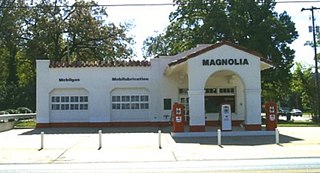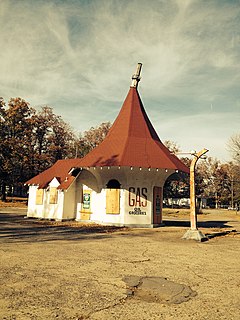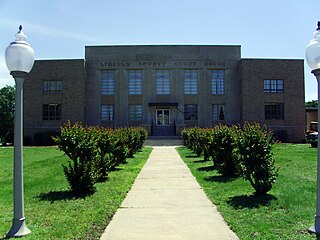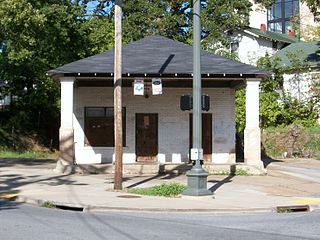
The Old State House, formerly called the Arkansas State House, is the oldest surviving state capitol building west of the Mississippi River. It was the site of the secession convention, as well as the fourth constitutional convention when delegates agreed to ensure voting rights for freedmen and establish public education.
Central Fire Station or Old Central Fire Station may refer to:

Dunbar Gifted & Talented Education International Studies Magnet Middle School is a magnet middle school for students in grades 6 through 8 located in Little Rock, Arkansas, United States. Dunbar Magnet Middle School is administered by the Little Rock School District. It is named for the nationally known African-American poet, Paul Laurence Dunbar.

Little Rock Union Station, also known as Mopac Station, is a train station in Little Rock, Arkansas, United States served by Amtrak, the national railroad passenger system.

Texarkana Union Station is a historic train station in the Texarkana metropolitan area serving Amtrak, the United States' national passenger rail system. The Arkansas-Texas border bisects the structure; the eastern part, including the waiting room and ticket office, are in Texarkana, Arkansas, but the western part is in Texarkana, Texas, meaning stopped trains span both states. The station was built in 1928 and was added to the U.S. National Register of Historic Places in 1978. Today it is the second busiest Amtrak station in Arkansas.

Capitol View/Stifft's Station is a neighborhood of Little Rock, Arkansas, in the west-central portion of the city encompassing approximately 1500 homes. Roughly, its boundaries include the area south of West Markham, north of Interstate 630, east of Pine, and west of Summit, as well as south of Riverview between Park and Summit. Capitol View/Stifft's Station is just west of Downtown, north of the Central High School Historic District, southeast of Pulaski Heights and uses the 72205 ZIP code.

The Central High School Neighborhood Historic District in Little Rock, Arkansas comprises the area surrounding Little Rock Central High School. The area was designated to provide historic context to the National Historic Landmark school. It includes the restored Magnolia Gas Station, which was a staging area for the media during the school integration crisis of 1957. Until the early 21st century, this building served as the National Park Service visitor center for the historic district. Residences in the surrounding area include bungalows, Tudor Revival and Colonial Revival styles.

The Governor's Mansion Historic District is a historic district covering a large historic neighborhood of Little Rock, Arkansas. It was listed on the National Register of Historic Places in 1978 and its borders were increased in 1988 and again in 2002. The district is notable for the large number of well-preserved late 19th and early 20th-century houses, and includes a major cross-section of residential architecture designed by the noted Little Rock architect Charles L. Thompson. It is the oldest city neighborhood to retain its residential character.

The Argenta Historic District encompasses significant historic elements of central North Little Rock, Arkansas. The area that is now central North Little Rock was known as Argenta when it was first settled, and remained unincorporated until it was annexed to Little Rock in 1890. William Faucette, a leading Argenta politician and businessman, orchestrated the incorporation of North Little Rock just beyond the annexed area in 1901, and then made a successful petition to separate Argenta from Little Rock into the new municipality in 1903. Subsequent attempts to rename North Little Rock to Argenta have failed.
Justin Matthews (1876–1955) was an Arkansas road and bridge builder and real estate developer. He helped to design and expand many areas in central Arkansas.

The Roundtop Filling Station, in Sherwood, Arkansas, United States, is one of only two structures in Sherwood to be listed on the National Register of Historic Places, the other being Sylvan Hills Country Club Golf Course.

The county courthouse of Lincoln County, Arkansas is located at 300 South Drew Street in Star City, the county seat. The two story building was designed by Wittenberg & Deloney of Little Rock and built in 1943. It is predominantly buff-colored brick, with limestone trim, and has a flat roof that is hidden by a parapet. The building's front, or western, elevation, has a central projecting section that is slightly taller than the wing sections, and is faced primarily in limestone. Four triangular stepped limestone pilasters frame the elements of this section, including the main entrance in the central bay, which now has replacement doors of aluminum and glass. Above the pilasters is a limestone panel identifying the building as the "Lincoln County Courthouse" in Art Deco lettering. It is believed to be the only Art Deco building in the county.

The Magnolia Company Filling Station is a historic automotive service station building at 492 West Lafayette Street in Fayetteville, Arkansas. It is a small single-story white hip-roofed brick building, with a portico, supported by brick piers, extending over the area where the fuel pumps were originally located. The building has a center entrance, with a single sash window to the left, and a large window to the right. Built in 1925, it is one of the region's oldest surviving gas stations, and, according to its National Register nomination in 1978 was the only one then known to have been built by the Magnolia Company and to still be surviving.

The Donaghey Building is a historic commercial building at 103 East 7th Street and 703 South Main Street in Little Rock, Arkansas. It is a fourteen-story structure, built out of reinforced concrete and faced in brick. The building forms a U shape, with a central courtyard open to the south. It was built in 1925–26 to a design by New York City architect Hunter McDonnell, and was Little Rock's tallest building for three decades, housing a variety of commercial offices, and retail spaces on the ground floor. It featured the latest advances in lighting, ventilation, and fire-resistant construction.

The Old Central Fire Station is a historic former fire station at 506 Main Street in North Little Rock, Arkansas. It is a two-story brick building, with a three-bay front facade dominated by a large equipment bay on the ground floor, now enclosed by glass doors. The building, whose construction date is not known, was acquired by the city in 1904, shortly after its incorporation, and initially housed city offices, the jail, and the fire station. In 1914 the town offices were moved to North Little Rock City Hall, and in 1923 the building's original two equipment bays were replaced by one. The horse stalls were also removed, as the new equipment was powered by gasoline engines. The building served as the city's main fire station until 1961.

The Railroad Call Historic District encompasses three adjacent railroad worker housing units at 108, 1112, and 114 South Pulaski Street in Little Rock, Arkansas. All three are single-story wood frame Colonial Revival structures, with gabled roofs and weatherboard siding, with some use of wooden shingles in gable ends. Two of the buildings have full-width front porches; the third has a half-width porch. These houses were built for workers constructing the nearby Missouri Pacific Railroad station. The buildings were saved from demolition in 1996 and converted to offices.

The Park Hill Fire Station and Water Company Complex is a collection of historic public facilities at 3417-21 Magnolia Street in North Little Rock, Arkansas. The complex consists of a fire station, a water company office, two concrete reservoirs, and two stone pump houses, all built in 1938 with funding support from the Works Progress Administration. The fire station and water company office are distinguished architecturally by their fieldstone exteriors and Mediterranean style, including red tiled roofs. They were designed by the Little Rock firm of Brueggeman, Swaim and Allen.

The Samuel P. Taylor Service Station is a historic commercial building at 1123 West 3rd Street in Little Rock, Arkansas. Built in 1938, it is an excellent example of a period automotive filling station with Art Deco styling. It is a single-story L-shaped structure, with three service bays set at different angles, and an office in front. A zigzag pattern of black tiles extends across the building's cornice, and black tile is used prominently around the main entrance and below the office windows.
The Magnolia Petroleum Company Filling Station is a historic automotive service station building at Larch and 1st Streets in Kingsland, Arkansas. It is a small single-story masonry building, built of red and buff brick and covered by a gabled roof. The front facade has a door on the left side and a plate glass window on the right. A concrete pad in front of the building originally supported the fuel pumps. The building was built about 1930, and is a good example of an early filling station with Tudor and Craftsman features, built to a Magnolia Company design which was used for at least one other filling station, in North Little Rock.


















